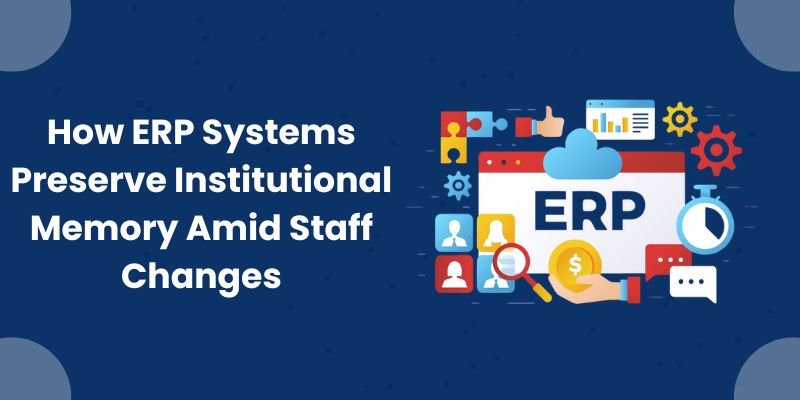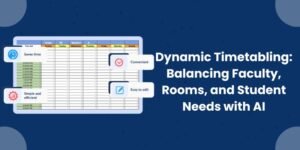In the ever-evolving landscape of education, change is constant. One of the most significant challenges faced by educational institutions is ensuring operational continuity despite frequent staff turnover. When key personnel leave—whether it’s administrators, teachers, or support staff—the loss of institutional knowledge can be both disruptive and costly. From student records to policy decisions and financial records, valuable insights and context often walk out the door with them.
This is where Enterprise Resource Planning (ERP) systems come in. ERP systems help educational institutions manage and automate essential processes, centralizing data in a single, accessible location. In doing so, they play a crucial role in preserving institutional memory, ensuring that no matter who leaves, the knowledge remains intact and easily accessible.
But how exactly does an ERP system contribute to the preservation of institutional memory, especially in the face of staff transitions? Let’s explore.
What is ERP and How Does It Work?
At its core, an ERP system is an integrated suite of applications designed to help institutions manage a variety of administrative functions. These can include student management, finance, human resources, academic scheduling, and more. By centralizing all of an institution’s data into a single system, ERP platforms allow for streamlined processes, real-time updates, and accessible records across different departments.
Unlike isolated systems—where data is spread across various platforms or spreadsheets—an ERP consolidates everything into one system. For example, a student’s records, financial details, and even interactions with faculty are stored in one place, enabling authorized personnel to access, update, and manage information seamlessly. The power of an ERP system lies in its ability to integrate information across departments, ensuring that data is accurate, consistent, and up-to-date.
But beyond improving day-to-day operations, ERP systems offer a significant advantage: they ensure that the institution’s institutional memory is protected and preserved.
Why Institutional Memory Matters
In any educational institution, institutional memory refers to the accumulated knowledge, experiences, and insights built over time. This encompasses everything from historical records of students, policies, and programs to nuanced decision-making and day-to-day operational knowledge.
When staff members leave, much of this knowledge can be lost—either because it wasn’t documented or because it was embedded in an individual’s head. For instance, if a long-serving administrator departs, they may leave with knowledge about specific budget allocations, student enrollment trends, or even personal connections with key stakeholders. Without an ERP system, this valuable information may be difficult or impossible to recover.
When an institution loses this memory, it can face a variety of challenges:
- Loss of continuity: Without institutional memory, new staff members may struggle to understand ongoing projects or historical trends, leading to inefficiencies and missed opportunities.
- Inconsistent processes: Staff turnover can lead to the inconsistency of how processes are carried out. What one employee has learned over years may not be transferred to the next person.
- Delayed decision-making: Key decisions that rely on historical data and insights could become slower or less informed without access to past records.
- Difficulty in onboarding new staff: New hires must learn the institution’s internal systems and processes, which could be hindered by a lack of proper documentation.
This is where ERP systems offer a transformative solution. They act as the institution’s memory, storing critical information and processes so that the institution can continue to operate seamlessly, even as staff transition in and out.
How ERP Systems Preserve Institutional Memory
1. Centralized Data and Records
One of the most significant ways an ERP preserves institutional memory is by centralizing data storage. Information such as student enrollment records, grades, fee structures, faculty performance, and historical decision-making is stored in one unified system. When staff leave, this information remains intact, accessible, and up-to-date.
For example, if a school’s head of admissions moves on, their knowledge about student demographics, preferred courses, and previous challenges can be accessed in real-time by the incoming staff. All records are preserved, from application forms to communication histories with parents or guardians.
Centralized data also eliminates the risk of lost or misplaced information, which can happen when records are maintained in different places—whether physical files or scattered digital platforms. By using an ERP, institutions ensure that all important data is preserved securely and easily retrievable, no matter who is managing it.
2. Audit Trails and Historical Data
ERP systems provide detailed audit trails, which track every change made within the system, including who made the change and when. This is crucial for maintaining transparency and accountability, but it also plays an essential role in preserving institutional memory.
Audit trails allow new staff members to see the rationale behind decisions made in the past. For instance, if a new financial officer takes over, they can review past budgets, decisions, and financial records to understand the context in which previous choices were made. This historical perspective can guide them in making decisions that align with the institution’s long-term goals and objectives.
Having these audit trails in place also enables institutions to retain historical data that might otherwise be lost when staff members leave. Instead of relying on personal recollections or handover notes, ERP systems provide hard evidence of how and why decisions were made, ensuring that continuity is maintained.
3. Standardized Processes and Workflow
Another key feature of ERP systems is their ability to standardize workflows and processes across departments. In educational institutions, different departments—such as admissions, finance, HR, and student services—often have different methods for managing their operations. This lack of consistency can create gaps in institutional memory.
An ERP system addresses this by ensuring that all processes are carried out according to the same standardized procedures. Whether it’s the process of handling student enrollment, issuing fee receipts, or managing human resources, the workflows within an ERP system are structured and consistent.
For example, the ERP system can automate the process of collecting fees, updating student records, or scheduling classes. As these processes are standardized across the institution, new staff members can quickly learn the ropes without missing a beat. They don’t have to guess how things were done previously—they can simply follow the established workflows.
4. Role-Based Access and Security
An ERP system ensures that only authorized personnel have access to sensitive data. Role-based access allows institutions to assign specific permissions to users based on their role within the organization. This ensures that institutional memory is not only preserved but also protected from unauthorized access.
For instance, while an administrator may need access to student records, faculty members may only need access to the courses they are teaching. Role-based access also allows for controlled sharing of institutional knowledge. New staff members can be given access to the data they need to carry out their responsibilities without compromising the privacy or security of other sensitive information.
By providing controlled access, ERP systems ensure that institutional memory is not only preserved but is also used appropriately and securely by those who need it.
5. Seamless Onboarding of New Staff
With the information centralized and standardized in the ERP system, onboarding new staff becomes much more efficient. Instead of spending weeks or months trying to understand existing processes or searching for scattered documentation, new staff can simply log into the system and start learning.
Since the ERP system stores institutional knowledge in one place, new employees can quickly get up to speed on the institution’s history, ongoing projects, and key decisions. This seamless onboarding experience reduces the time and resources needed to train new staff and allows them to contribute to the institution’s success faster.
In today’s dynamic educational environment, staff turnover is inevitable. However, the loss of institutional memory does not have to be. With the implementation of an ERP system, educational institutions can ensure that their critical knowledge and insights are preserved, even as staff members come and go.
By centralizing data, providing audit trails, standardizing workflows, and offering role-based access, ERP systems act as the institution’s memory bank—allowing both existing and new staff to have access to the same rich history of decisions, practices, and records. This continuity is crucial for the smooth operation of the institution, ensuring that processes remain consistent and decisions are made based on comprehensive historical insights.
In an era where educational institutions must operate efficiently and adapt quickly to change, ERP systems provide the necessary infrastructure to preserve knowledge, improve operational continuity, and foster long-term success.












